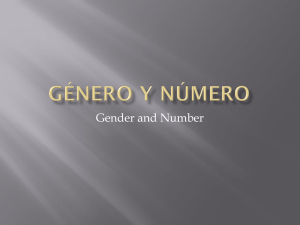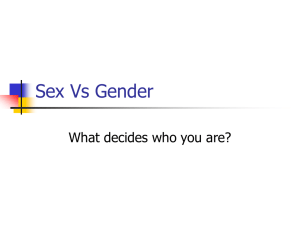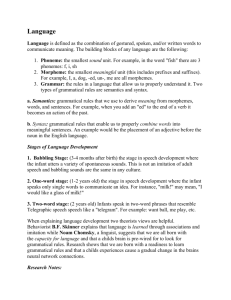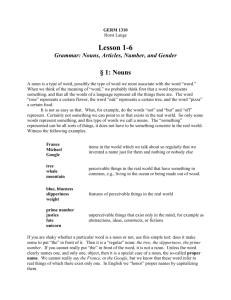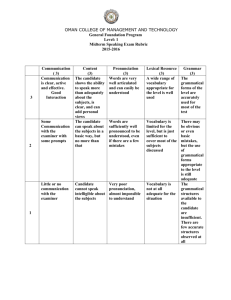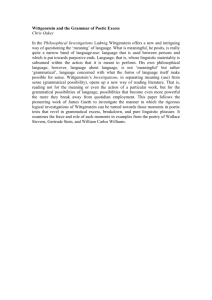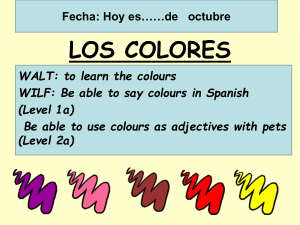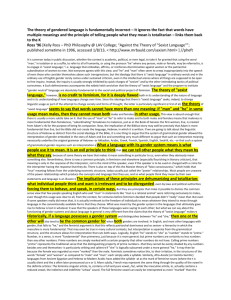PerryJeffreyUnit2
advertisement
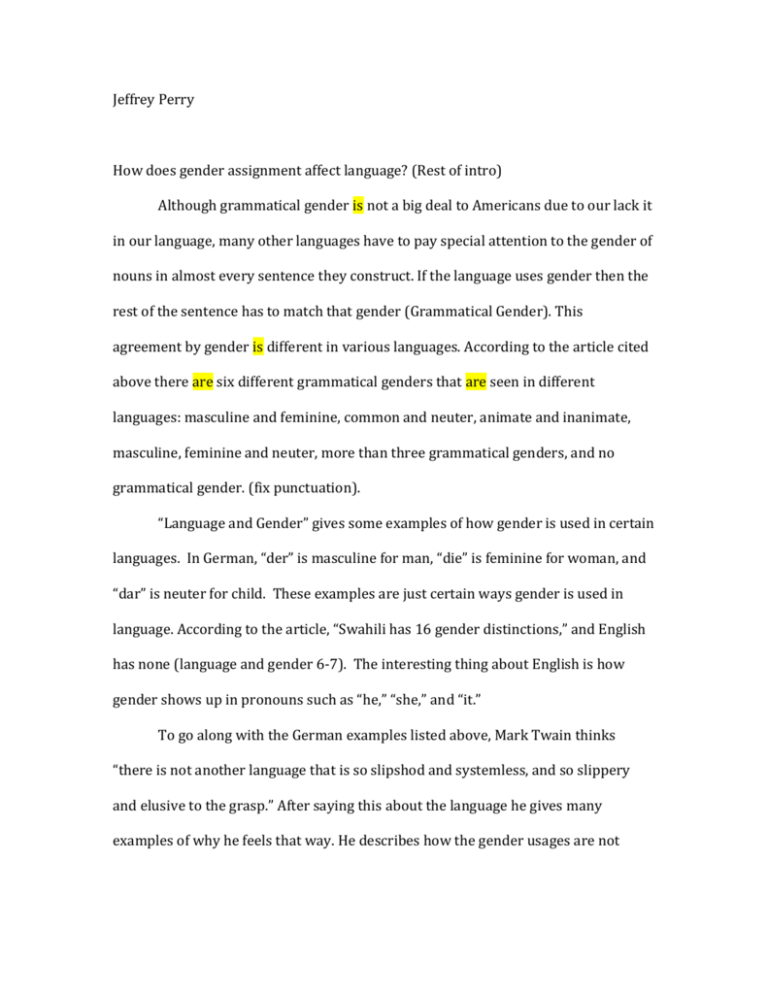
Jeffrey Perry How does gender assignment affect language? (Rest of intro) Although grammatical gender is not a big deal to Americans due to our lack it in our language, many other languages have to pay special attention to the gender of nouns in almost every sentence they construct. If the language uses gender then the rest of the sentence has to match that gender (Grammatical Gender). This agreement by gender is different in various languages. According to the article cited above there are six different grammatical genders that are seen in different languages: masculine and feminine, common and neuter, animate and inanimate, masculine, feminine and neuter, more than three grammatical genders, and no grammatical gender. (fix punctuation). “Language and Gender” gives some examples of how gender is used in certain languages. In German, “der” is masculine for man, “die” is feminine for woman, and “dar” is neuter for child. These examples are just certain ways gender is used in language. According to the article, “Swahili has 16 gender distinctions,” and English has none (language and gender 6-7). The interesting thing about English is how gender shows up in pronouns such as “he,” “she,” and “it.” To go along with the German examples listed above, Mark Twain thinks “there is not another language that is so slipshod and systemless, and so slippery and elusive to the grasp.” After saying this about the language he gives many examples of why he feels that way. He describes how the gender usages are not logical and do not make much sense. One of these examples is “a tree is male, its buds are female, its leaves are neuter” (Language and Gender 10). All these different genders play a role in the thinking of the speaker. This is displayed by the experiment described in “Masculine or Feminine? (And Why It Matters).” In the study Russians were given the task of characterizing the days of the week. The masculine days of the week (Monday, Tuesday, and Thursday) were described in masculine ways and the feminine days (Wednesday, Friday, and Saturday) were described in feminine ways. They were not even aware that they did this; it came natural to them. This experiment leads to the conclusion that the grammatical gender of the language affects their cognition (White 1). Another study spoken about in the same article describes a study done with Spanish and German speakers. 24 words were chosen that have opposite gender in the languages. The study required them to describe the word “key” in English. “Key” is masculine in German and feminine in Spanish. Germans described it as “hard, heavy, jagged, metal, and useful,” while Spanish speakers used words such as “golden, intricate, little, lovely, and tiny.” This study points to the idea that even when speakers are talking in a different language, “grammatical gender can influence people’s thinking” (White 1). In Spanish language, grammatical gender is taught starting in second grade. This gives them an edge in classifying objects female or male. A study described by Maria D. Sera and Christian A.H. Berge gives some interesting results. The study is set up with English and Spanish Speaking children. They were asked to classify pictures shown. The first set of pictures had no labels and the second had labels. The Spanish-speaking children relied on their languages grammatical genders to classify the pictures as male and female while English speaking children did not have that ability. The results concluded that English speakers usually classified natural objects as female and artificial as male. The study “found that the artificial-male/naturalfemale link was an earlier force in classification for speakers of English than grammatical gender was for speakers of Spanish, suggesting that grammatical classifications are superimposed on conceptual ones in development” (Sera 1). The grammatical gender of Spanish is for the most part based on the ending of words. The fundamental rule to tell if words are masculine or feminine is shown at the end of the word. If the word ends in “o” it is usually masculine and if it ends in “a” it is usually feminine. This can be seen in “amigo” and “amiga.” Amigo refers to a male friend and amiga refers to a female friend (Harris 1). One experiment used 160 Spanish children from four to eleven years old. These children were asked to give the grammatical gender of a word based on whatever clue was given to them to help. These clues were either semantic, morphophonological, or syntactic, or a combination of the clues. The experiment aimed to decide which clues were more helpful for determining the gender. The results showed that syntactic and morphophonological clues were stronger than semantic clues. The stronger ones were intralinguistic which meant they were more based on language rather than semantic (Perez-Pereira 1).

